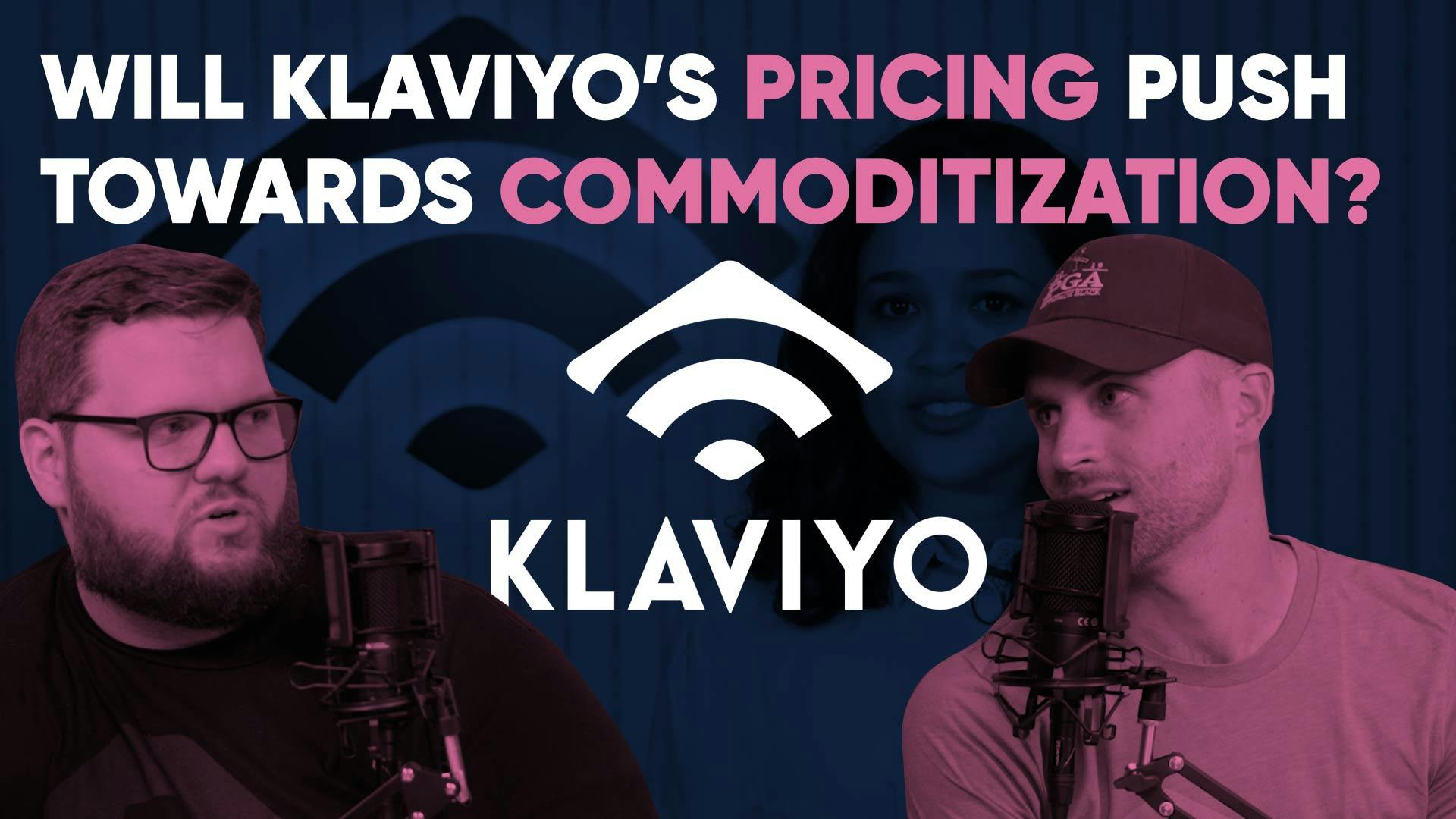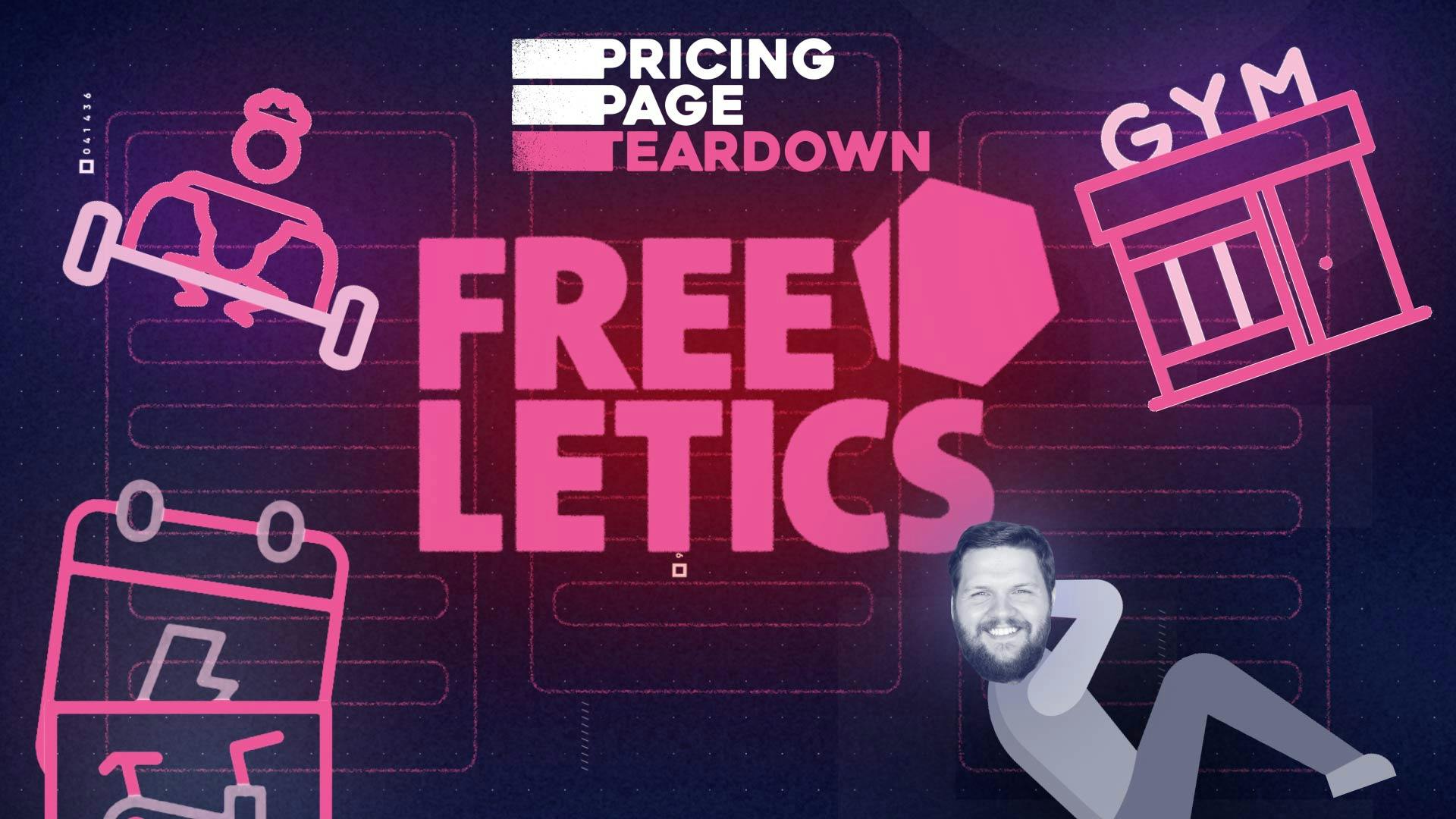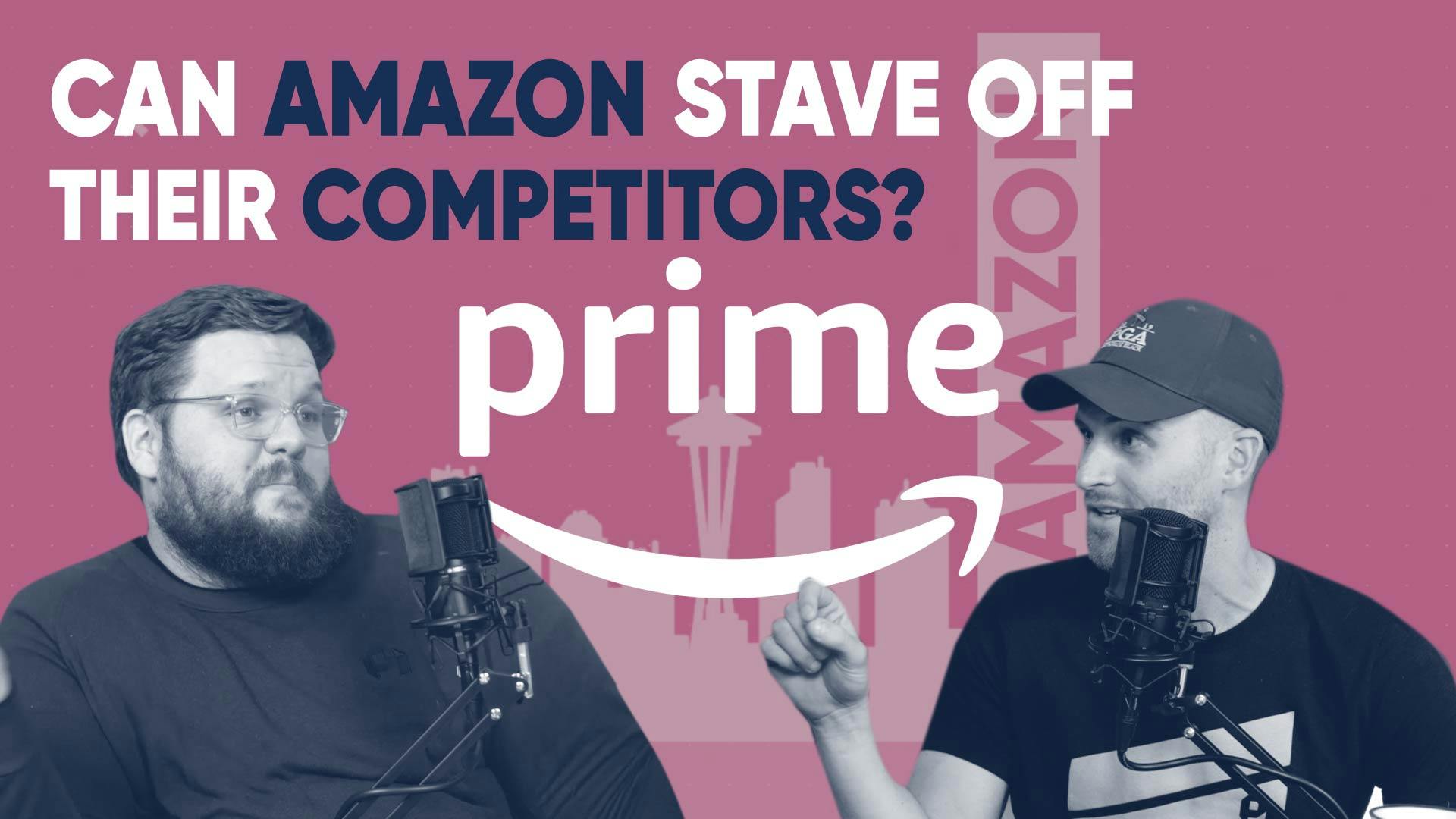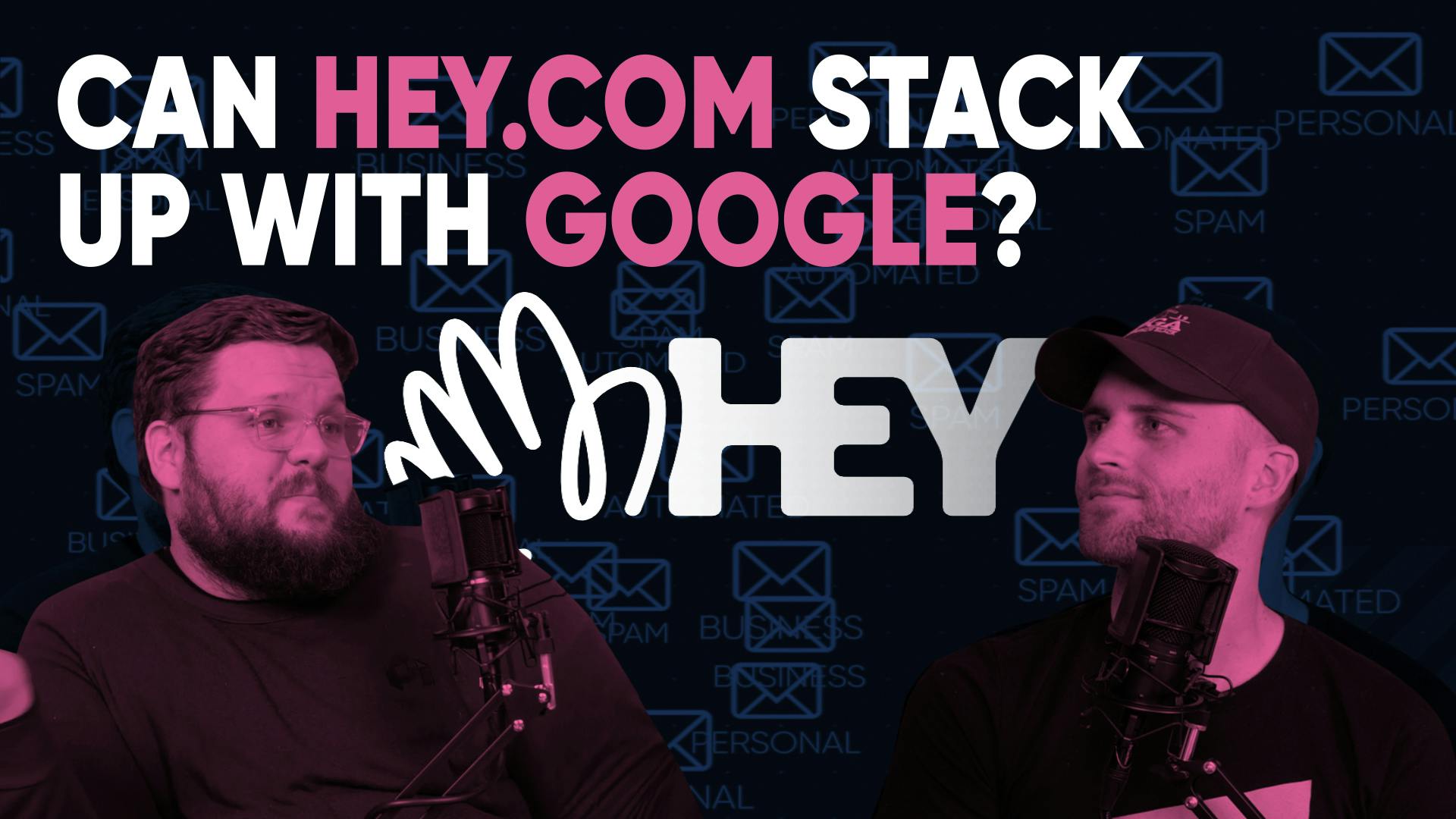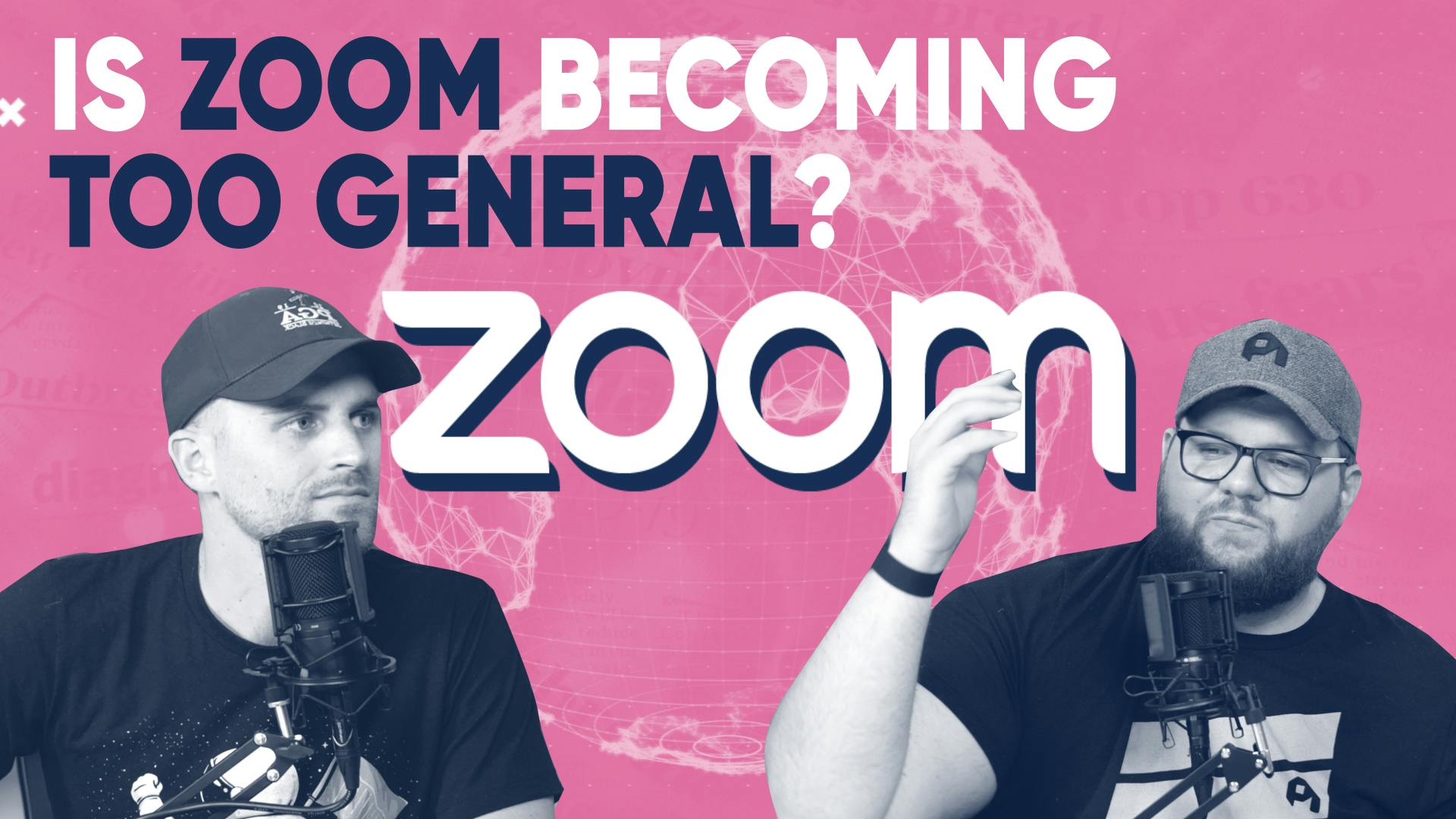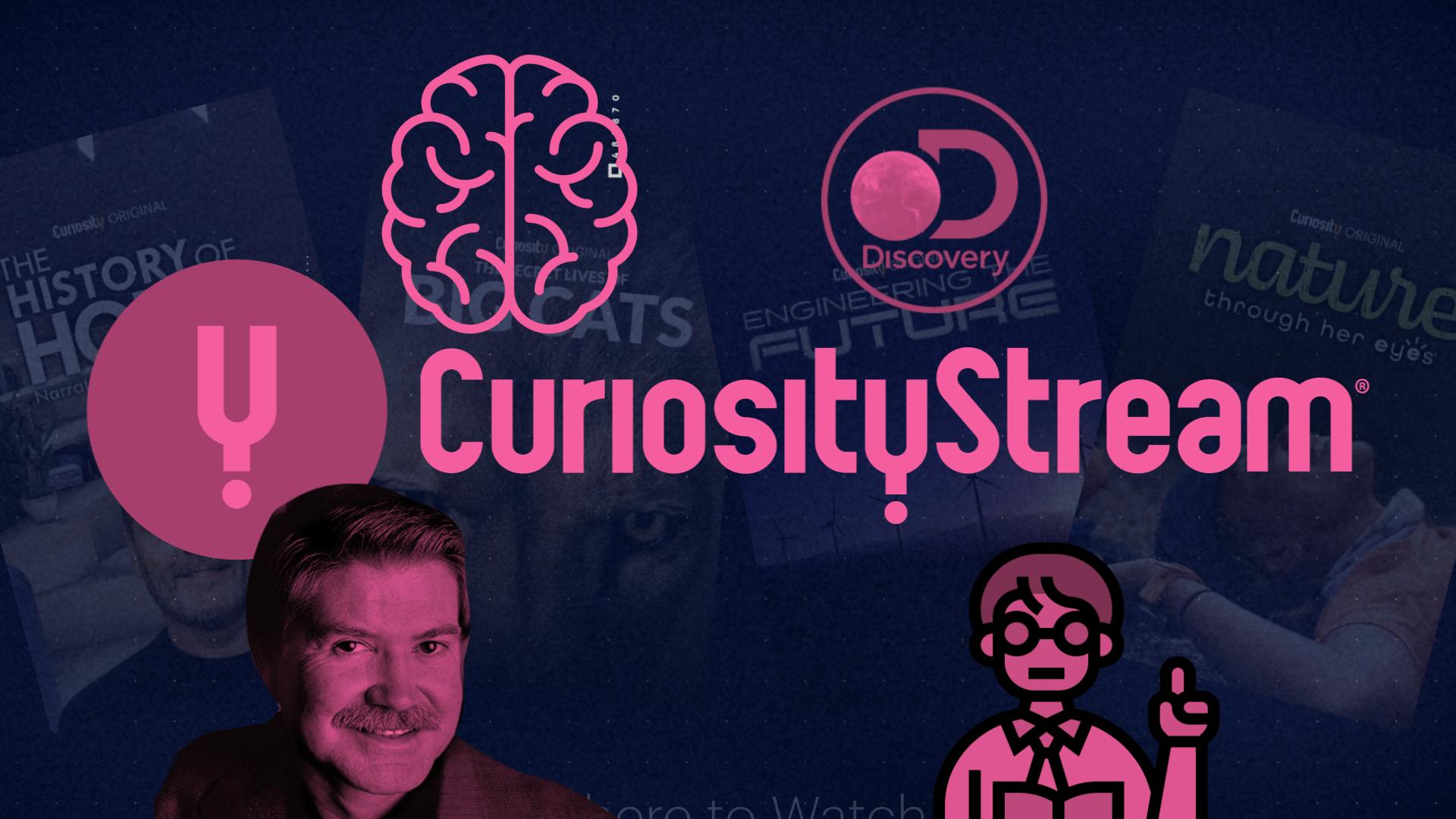
Can Netflix stay relevant?
This episode might reference ProfitWell and ProfitWell Recur, which following the acquisition by Paddle is now Paddle Studios. Some information may be out of date.
Please message us at studios@paddle.com if you have any questions or comments!
Innovation has led to Netflix being the behemoth in the market with 200M subscribers worldwide and 20 billion in annual revenue. But with all this success and innovation comes competition. And the competition has something Netflix doesn’t. Can Netflix stay relevant and continue to grow in what has become such a crowded market?
Below are some valuable takeaways you can implement in your own business.
- Netflix has great pull pricing
Pull pricing is a pricing strategy designed to naturally draw (“pull”) consumers to an upgrade. When you have a consumer product, you don't want to push someone to a price. You want them to naturally be pulled up because you will not only get higher lifetime value (LTV) from average revenue per user (ARPU), but you also get higher LTV from retention.
Netflix does this well and understands that there are certain levers they can pull to get people to pay more. And the things Netflix is using to pull people up, are the exact things that people are willing to pay more for.
undefined - Localization is key (and Netflix is doing it right)
Localization, the practice of adjusting prices to local markets, correlates with more growth. Cosmetic localization (changing the currency to match the region) correlates to 30-45% higher growth rates. Market-based localization (measured willingness to pay in each region) results in double the growth rates of non-localized pricing.
Netflix understands there's a different willingness to pay in other regions. And that there is an ability to capture new customers by changing prices for the same content in those regions.
undefined - Understand your competitive environment
As an operator it’s important to know how competitive your market is. However, focusing on the right things is key. You have to understand what willingness to pay looks like. Additionally, you must understand what makes you unique. Don't use your competition as the North Star within your pricing. Use it as an input, particularly for packaging and positioning.
undefined
Remember when Netflix shipped DVDs directly to your mailbox and before you could watch another show you had to mail the DVD back? Yeap, that was life back in the day. Now, you order some Postmates and can burn through a whole season of Bridgerton without even getting up to go to the bathroom.
What’s wild is that the world before Netflix’s DVDs was even more annoying. Let’s take you back to the 90s. Grunge was in style, dot coms were booming, and if you wanted to rent a movie or TV series you had to go to a physical store. Remember those? Not only was it inconvenient to go to the other side of town just to find out the movie you wanted to see was sold out, but it was expensive. If you forgot to drop off that copy of Apollo 13 on time, you could get hit with a $40 late fee. Don’t even get me started on rewind fees.
The inconvenience and fees led Reed Hastings and Marc Randolph to found Netflix in 1997 with 2.5M dollars. They envisioned a product that basically eliminated all the annoyances that came with physical stores. With the rise of shipping from ebay and amazon, Randolph and Hastings went all in, on DVD technology shipped right to your door with no late fees - all for one monthly subscription price.
Netflix's success
The compounding nature of subscribers, as well as the commitment to eliminating all friction to entertainment led to wild success and a billion dollars in revenue by 2007. Netflix didn’t rest on their laurels though, they innovated by eliminating even more friction when they started the first mass market streaming service, shortly thereafter. Now customers didn’t even have to go to their mailbox to be entertained. Netflix continued to grow and even innovated by producing their own content, based on their viewer data. All this innovation has led to Netflix being the behemoth in the market with 200 million subscribers worldwide and 20 billion in annual revenue.
But with all this success and innovation comes competition. While people laughed at Reed and Marc for shipping DVDs, and even going through the Qwikster debacle—they’re clearly winning, so companies with deep pockets want in on the action. Amazon, Disney, HBO, NBC, CBS, and all the old school entertainers are now in the game, spending billions to attract eyeballs and watch time. These competitors also have what Netflix doesn’t—merchandise deals, ad networks, and some, even have physical destinations to expand their revenue per customer.
Critics also point out that the deluge of content is diluting any semblance of quality and while quality content will always win, there just might be so much content out there it doesn’t matter, especially as YouTube and other non-episodic content continue to raise the stakes. Netflix is fighting back, through internationalization and spending billions on content, including $17Bn in 2020.
The question becomes: With seemingly no more physical distance to reduce in getting you entertainment—unless they plug right into your brain—as well as a world where quality in terms of content is becoming too relative, what can Netflix do to continue to grow? Will they go into different mediums, such as video games, sports, merchandise? How will they compete with other companies like Disney who have more nostalgia-based content? It seems this market is Netflix’s to lose, but we’re going to answer these questions and more by collecting data from 10, 542 current and prospective Netflix customers.
Inconvenient to cancel
I don't know if you remember early Netflix—early streaming, and the DVDs. DVDs were fascinating, but people just kind of conceptualize the streaming part, now. I would treat it almost like the DVDs, where I would buy it, I would watch the thing I was going to watch, and then I would churn. And then I would come back whenever they had something new. As soon as House of Cards came—not just House of Cards, but enough of their originals and when their catalog was big enough—it became too inconvenient to cancel.
I know it sounds insane because if you look at the lessons of Netflix, they focused on one thing that was crucial to their success. It was the amount of content that a user and all of these different fragmented types of users had to watch—either entirely over and over again or new shows—to maintain their subscription.
Netflix did really well with the data science and this understanding of what was needed to win in terms of content. And they kind of flipped it on their head. Netflix had the hundred-million dollar series. But they also had the little stuff they knew three-million people were going to watch, but it was the right three-million people to keep them coming back. And that's how they justified spending more than I think most incumbents did on content.
But here's the thing many people don't realize in their business: even though you're focused on that one thing, it has to evolve with the times. Netflix now has Disney Plus to deal with. But in the context of all this competition, they've gotten even more intense.
Notice how in the past six months they started advertising to viewers:
- Here's the number-one thing in the US.
- Here's the number-one thing in the world.
- Here's the number-one thing today.
- Here's the number-one thing yesterday.
Suddenly, their prediction algorithms got good. It's to the point where if everyone thinks it's good then I should watch it. I need to watch it. And they're doing other things like, "Hey, if you're not watching, we'll put it on pause." And they still focus on providing as much content as humanly possible to keep that person around.
Netflix's pricing page
Super simple
Looking at their pricing page, it's super simple, but they still differentiate packages. I think this is interesting. When you talk about consumer apps, most try to keep one consistent price. Netflix understands that there are certain levers they can pull to get people to pay more. And you can see that with the premium plan. You see that with standard and the upgrade from basic.
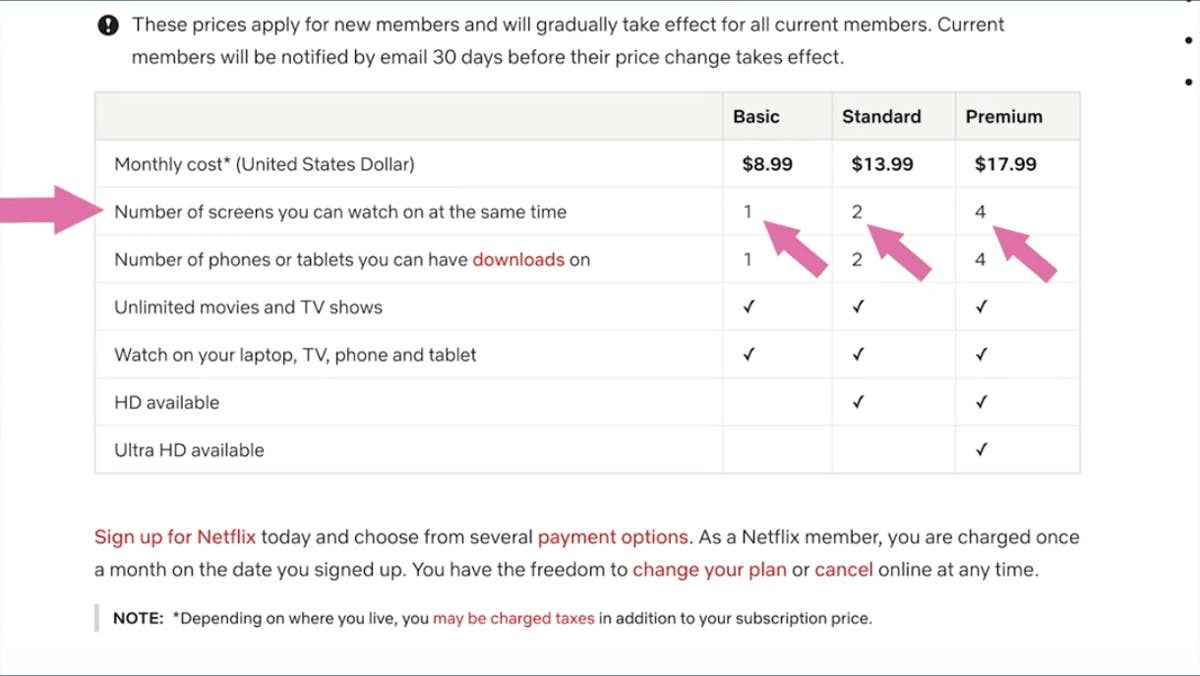
I think what's fascinating about this is the simplicity plan. The instinct for most consumer products is to have a single price. And it's primarily driven by a mobile experience. But here, you're not necessarily on a mobile experience, exactly. You're looking at a modified version for both mobile and television.
What's fascinating is that you don't need a single price. The one thing that Netflix could do is if the single price was required for the amount of screen space, they get you on an initial price and then upgrade you based on some triggers.
The main trigger you can see is the number of screens. This is really good, not only for families but also individuals. If you share a password, you get into a higher-end plan so that everyone has a Netflix subscription or has access to one because many people are hopping on these number of screens.
And the only other differentiation here is HD or ultra HD, which is 4k, and that gets the people who really care. That upgrade to Ultra HD is going to catch a lot of people.
Data and analysis
Great pull pricing
Pull pricing: A pricing strategy designed to naturally draw (“pull”) consumers to an upgrade.
We touched on this already, but Netflix has great pull pricing to let users choose to move up in price. So push versus pull pricing, we've talked about this a couple of different times. Push pricing is almost punitive. If you want a certain feature, you have to upgrade. You're also going to get all these other features that you probably don't want, but you want that one thing.
Pull pricing is when I care or use more of it, I’m naturally just going to get pulled up.
So, as we saw on their pricing page, it comes down to the number of screens. Or, if you're interested in a higher fidelity or higher definition, I should say experience. When we look at the data, you'll see what they're using to pull people up are the exact things that people are willing to pay more for.
We see this consistently with people who care about their pricing. Netflix is known to care about everything, which is a good sign and has helped with its dominance. And overall, they're spot on with the median price point, right around $11 per month, which aligns with their middle tier.
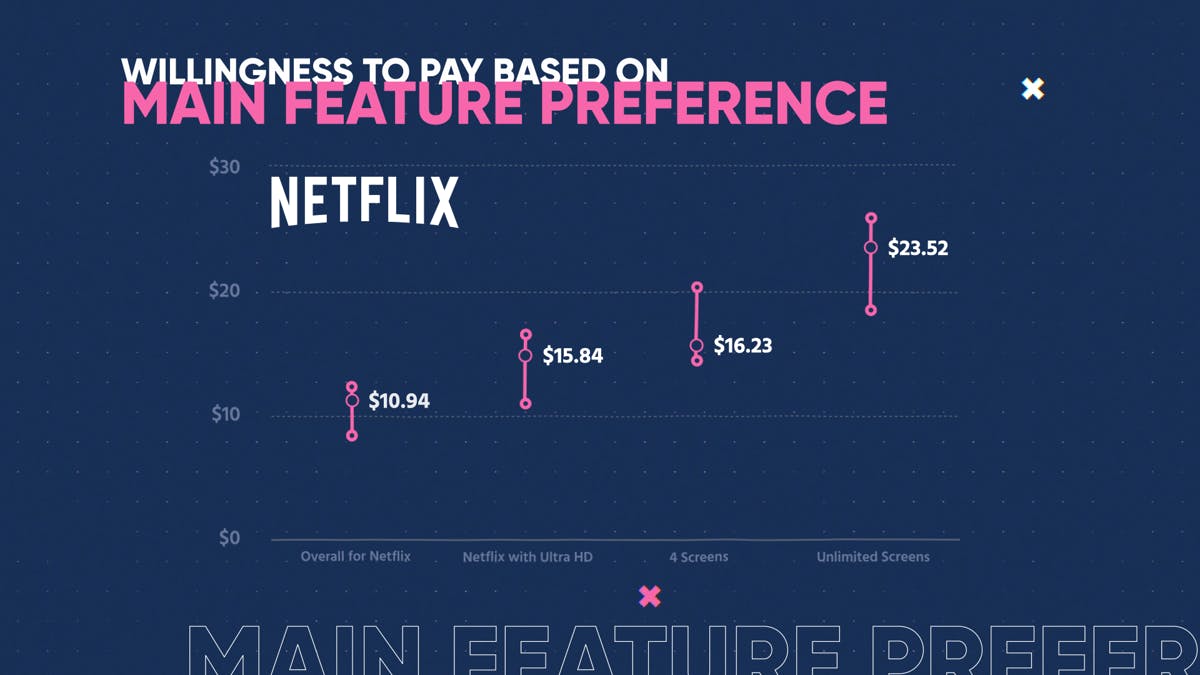
But you do have people who are willing to pay more. Particularly the folks who’s number-one feature is Ultra HD, and the folks that care about the four screens, which are the only two things that'll push you to that $15, $16 a month plan. Now it's kind of fascinating that there is an option for unlimited screens. I wanted to test this just to see what people would think.
And the reason is because the word "unlimited" is more of a marketing tactic than it is an actual monetization tactic. I typically wouldn't use this from a monetization perspective. You're capping your growth because people are willing to pay more for less. But if you find a particular feature or functionality that you can game a little bit and market a little bit further, there might be some opportunities there.
Of course, with an unlimited plan, if Netflix can't figure out how to protect their downside, there's just a ton of people who will end up using this and sharing it. But it shows a distance that they can push to get people to a $20 per month plan. I don't know if it will be based on screens or features, but there's something there because people are more than willing to pay for these higher-end plans.
Now, in the context of Disney, it’s fascinating to think about. When you think about Netflix in particular, you have a world where Disney has essentially gone to the low end of the market, even though they have more brand equity. They’re priced right around $6.99 per month. And if you do a bundle, it's like $12 a month and you get Hulu as well as ESPN plus.
I think Netflix is definitely at the higher end of the market competitively. But it doesn't mean there aren't more people willing to pay a higher price. And I think Netflix has to figure out whether they want to do some sort of add-on, whether they want to do more revenue streams, or should they just stay the course and defend their base. They'd do that by adding more users to ensure that they don't churn out, which is a bit of a dangerous game when the market becomes much more competitive.
It's going to be interesting with HBO Max. If you think about the Netflix strategy and the HBO strategy, there's a combination. I mentioned this earlier, but there's premium original ontent, and there's filler content.
They had Friends. They had The Office. It's critical to have the stuff that people will watch—like West Wing—over and over again between the originals to sustain subscribers. Otherwise, you end up with cliffs where people fall off and then resubscribe. So it's going to be interesting. There's an opportunity for a higher tier, but I wonder how they’ll differentiate.
I think it's similar to Spotify who we've studied as well. They need to figure out how to do different revenue streams. Not because they aren't going to continue to grow their base and their core membership, but because it's about growth and faster growth.
Amazon and Disney, and some of these other products that have streaming services now, also have a bunch of other stuff to sell.
Consider Disney parks. The minute they start bundling Disney parks stuff with Disney subscriptions, all of a sudden, and it’s not an either/or situation like everyone’s treating it, but Disney’s going to be monetizing this so much better than Netflix. So I think Netflix needs to consider how they will continue to be relevant. And it's going to come from great content sticking to their core. But they might need to get a little uncomfortable with how they monetize, which they've shown no indication of being able to do.
Localization is key
Localization is key and a great case study with Netflix. For those at home, localization means essentially charging different prices for the same product in other places. Willingness to pay fluctuates in these different regions.
You can see that here perfectly with Netflix. We've got Pakistan and Kenya down on the low end with much lower willingness to pay. They'll pay like $5 a month. The Nordics are up there at about $15 a month, I think on the other end. And both of them fluctuate pretty heavily from the United States where their market is most dense.
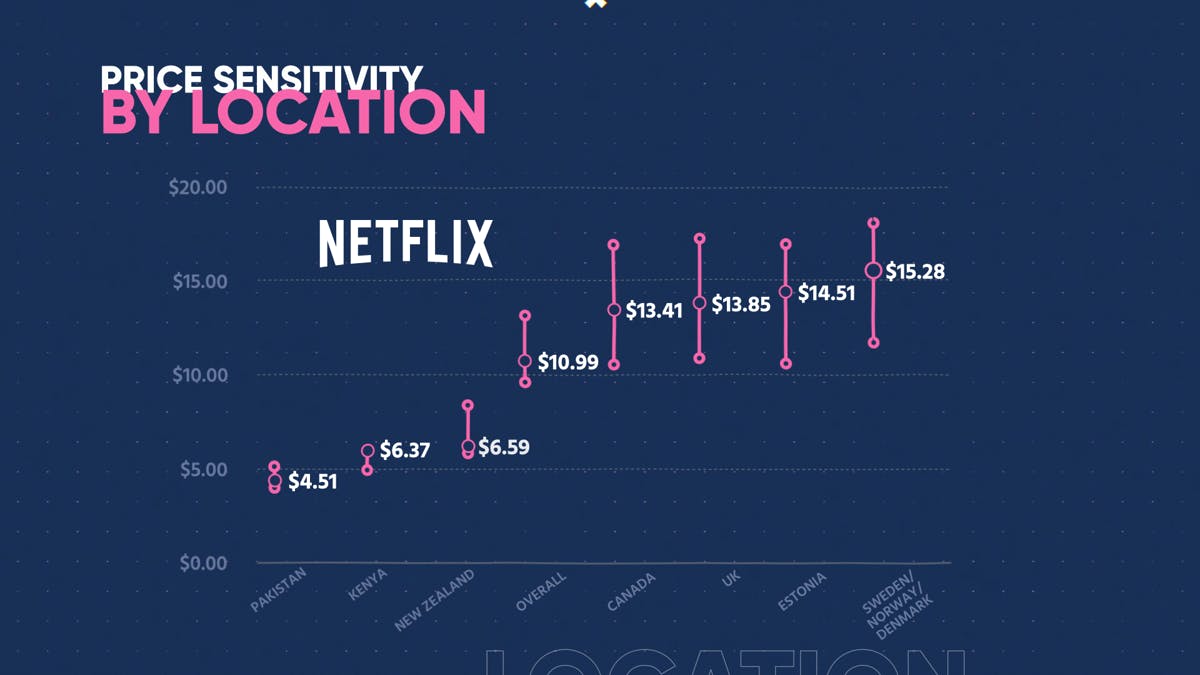
And this has controls for things like VAT (value-added tax), as well as the exchange rate. That's some criticism we often get. These are actual willingness-to-pay differentials.
What's interesting about this for your business is that you can consider different densities, different competitive structures, as well as just different living standards in a bunch of other places across the world. Even in a B2B environment, the UK and Western Europe are willing to pay probably about 15-20% more net. When you compare that to the United States, the Nordics typically pay 25-30% more.
One thing Netflix has done well—and they haven't done this from a pricing strategy but a contract strategy—is preview the content. The content can be teased but not played.
They've also done an excellent job ensuring the prices are different in different regions. And I don't know if you ever travel with Netflix, but the content is different from one location to the next, because of other preferences and things like that.
The big lesson is this: people of different regions have different preferences. You'll have other competitive structures in different places, and your pricing should be different in different areas as well.
Understand the competitive environment
You have to realize the competitive environment. We don't talk a lot about competitive pricing here. Not because it's not essential, but because most people put way too much of an emphasis on competitors. They think, "Oh, we're so competitive," when in reality, your competition is an action, or a spreadsheet, or a pad of paper with your customers, rather than the actual competitor that you have.
But in the world of Netflix, I think they should be worried because of what we've seen. And we alluded to this a couple of times. The world of Disney Plus has a lot of content that was bringing people to Netflix.
We did a value matrix not only of Disney-Plus members or those potentially going after Disney Plus, but also Netflix folks.
When we look at the differentiable feature quadrant, basically the upper right—Marvel, Disney Channel content, Pixar movies, Disney movies, and the far left here, which is also valuable content—Star Wars, Indie content, and even NBC content, those are valuable pieces of content. But Netflix is essentially lost.
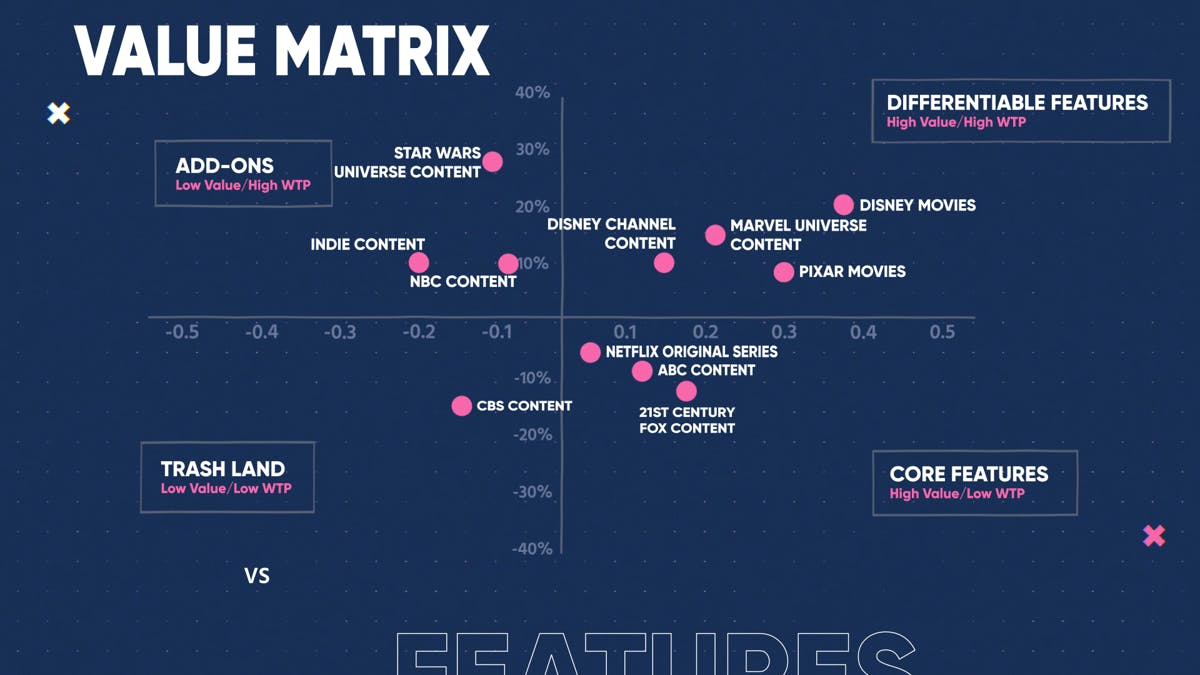
Subscribers are moving to Disney Plus, or their contracts are weaning down. Now, this doesn't mean that Netflix is completely screwed, but it does mean that Netflix needs to think, "Hey, there is something here. This competitive pressure is going to affect us more than we typically think."
And so what I like to say, in terms of competitive pressure, is that you must run your value-based data first. You have to understand what willingness to pay looks like, what segments care about different things, et cetera. Additionally, you must understand what makes you unique. What is that North Star you're going after?
For Netflix, it was content and data-driven content. Then you want to look at your competitors. So, in this case, Netflix is losing a lot of this high-value content. So they need to adjust their standards. For example, maybe they become the Thursday, Friday-night type TV versus the big box office series. Maybe they kind of readjust who they are, and they become that particular part of the niche, rather than going after all online media. That was what they were doing during the first few years of the streaming business.
You have to keep in mind how competitive your market is and realize as an operator, you're going to over-index it. But make sure that if your competitor keeps talking about one thing and that's costing you customers, you probably should be talking about that, and sling back a little of that context, as well.
For us, accuracy was a huge differentiator. It's colossal, like a North Star for us. And what ended up happening—when we kept talking about that—our competitors had to start talking about their accuracy as well. We'd have "bake-offs" in terms of our accuracy versus theirs, which allowed us to entrench our place in the market. We forced people to at least ask about accuracy, which was beneficial to us.
- Great pull pricing lets users move up in price based on features. We saw this with high definition, ultra-high definition type content, and the number of screens. Keep in mind when you have a consumer product, you don't want to push someone to a price. You want them to naturally be pulled up because you not only get higher LTV from ARPU, but you also get higher LTV from retention.
And Netflix does that very well. It aligns so well with their entire ethics code. They don't even want you to be a subscriber if you're not using it. They only want you to use their platform and their products. They want to know if you're going to keep watching. - Localization is key. Netflix understands there's a different willingness to pay in other regions. And there is an ability to capture new customers by changing prices for the same content in those regions.
- Understand the competitive environment. Netflix had the streaming market to themselves for quite some time. Amazon crept out there, but with nowhere near the budget that Netflix had.
You have a worthy competitor in Disney, which batches both HULU and ESPN into the mix. So don't use this as the North Star within your pricing. Use it as an input, particularly for packaging and positioning. You should always compete on price in a good way, meaning you shouldn't have to go to the race to the bottom. You want to make sure your packaging and positioning adjust in the context of those competitors.
Need help with your SaaS pricing?
Price Intelligently by Paddle is revolutionizing how SaaS and subscription companies price and package their products. Founded in 2012, we believe in value-based pricing rooted in first-party research to inform your monetization strategies. We combine expertise and data to solve your unique pricing challenges and catapult growth.
(00:00):
They're taking on Pixar, Mickey Mouse, the Avengers, star Wars, and just every Disney collection. They have known demand with Michael Scott and Michael Scott is gonna be gone in 2021.
(00:13):
Welcome to pricing page Teardown, where the Profitell Crew breaks down strategies and insights on how subscription companies from all corners of the market can win with monetization.
(00:28):
Welcome to Pricing page Teardown. I'm Patrick Campbell. I'm Rob Litterst. And this week we are taking on a company that has essentially done the impossible time and time and time again, and that is Netflix. Love Netflix. Netflix took on the DVD realm. Everyone told them that they weren't gonna make it, they were gonna fail. They had a little bit of a quickster problem in the middle of there. Yep. Then they went after streaming. Everyone told them that they're gonna fail and now everyone's telling them they're gonna fail because Disney Plus, which is like an amalgamation of Disney plus Hulu and ESPN is gonna take them on and crush them. They're resilient. I, they're definitely resilient, but this is the hardest competitor that they've ever faced. And it's a super, super fascinating case study that we're gonna be able to study not only what they're doing well, but what they're doing not so well in the context of the new competition within the market. And finally, figure out how you can package this together to get your own monetization strategy on the right track.
(01:26):
Remember when Netflix shipped DVDs directly to your mailbox and before you could watch another show, you had to mail the DVD back. That was life back in the day. Now you order some Postmates and can burn through a whole season of Bridger without even getting up to go to the bathroom. What's wildest that? The world before Netflix's DVDs was even more annoying. Let's take you back to the nineties. Grunge was in style dot coms were booming, and if you wanted to run a movie or TV series, you had to go to a physical store. Remember those? Not only was it inconvenient to go to the other side of town just to find out the movie you wanted to see was sold out, but it was expensive. If you forgot to drop off that copy of Apollo 13 on time, you could get hit with the $40 late fee.
(02:04):
And don't even get me started on those rewind fees. These inconveniences and fees led Reed Hastings and Mark Randolph to found Netflix in 1997 with 2.5 million. They envisioned a product that basically eliminated all the annoyances that came with physical stores. With the rise of shipping from eBay and Amazon, Randolph and Hastings went all in on DVD technologies, shipped right to your door with no late fees, all for one monthly subscription price. The compounding nature of subscribers, as well as the commitment to eliminating all friction to entertainment led to wild success and a billion dollars in revenue. By 2007, Netflix didn't rest on their laurels, though they innovated by eliminating even more friction when they started the first mass market streaming service shortly thereafter. Now customers didn't even have to go to their mailbox to be entertained. Netflix continued to grow and even innovated by producing their own content based on their viewer data.
(02:56):
All this innovation has led to Netflix being the behemoth in the market with 200 million subscribers worldwide and 20 billion in annual revenue. But with all this success in innovation comes competition. While people laughed at Reid and Mark for shipping DVDs and even going through the quicker debacle, they're clearly winning. So companies with deep pockets, one in on the action, Amazon, Disney, hbo, o, nbc, cbs, and all the old school entertainers are now in the game spending billions to attract eyeballs in watch time. These competitors also have what Netflix doesn't, merchandise deals, ad networks. Some even have physical destinations to expand their revenue per user. Critics also point out that the Delusive content is diluting any semblance of quality. And while quality content will always win, there just might be so much content out there, it doesn't matter, especially as YouTube and other non episodic content continue to raise the stakes. Netflix is fighting back through internationalization and spending billions on content, including $17 billion in 2020. The question becomes, what can Netflix do to continue to grow? Will they go into different mediums such as video games, sports merchandise? How will they compete with other companies like Disney who have more nostalgia based content? It seems this market is Netflix's to lose, but we're gonna answer these questions and more by collecting data from current and prospective Netflix customers. We'll reveal all the data and answers to these questions in just a bit.
(04:20):
So I'm actually not subscribed to Netflix right now. Oh, interesting. Why is that? I'm gonna tell you why. So my wife and I, about a year ago, notice this, this, but you don't watch Netflix at all right now. So I'm, I'm using my brother's account when I absolutely get him. Need to get 'em breed passports. Exactly. Exactly. But what happened about a year ago, my wife and I noticed another name on our login screen that's interesting. And it was a guy named Nome, apparently <laugh> and uh, so he was kind of our Netflix, our extended buddy Netflix family. Yeah. So he was using it. He somehow hacked in, what do you watch on Netflix? So I like Stranger Things. Um, I like the fact that they, I think they do it right, like they have a really good blend of content. They have like the standup comedy, which is awesome.
(05:01):
Yeah. I don't know if you remember early Netflix, early, early streaming. Let's just talk about the stream or did you use the DVDs? Oh no, I used early streaming too. Yeah. And And the DVDs. Yeah, so DVDs were really fascinating, but people just kind of conceptualize the streaming part. Now I would treat it almost like the DVDs where I would like buy it. I would watch the thing I was gonna watch and then I would churn. Yeah. And then I would come back whenever they had something and then as soon as like House of Cards came, all of a sudden that's when I feel like not just House of Cards, but enough of their originals as well as their catalog was big enough. Oh yeah. That it just became like too inconvenient to cancel, which I no sense insane. Because if you look at the lessons of Netflix, they focused on one thing that was absolutely crucial of their success.
(05:42):
And it was essentially the amount of content that a user and all these different fragmented types of users had to watch either completely over and over again or new shows in order to maintain their subscription. Right. And I think they did really, really well is the data science and this understanding of what needed to win. Totally. In terms of content. And they, they kind of flipped it on their head. They did have the like hundred million series, but then they also had like the little stuff that they knew 3 million people were gonna watch. But it was the right 3 million people to kind of keep them coming back. And that's how they justified Totally. Spending more than I think most, um, most incumbents on content. Totally. But here's the thing that I think a lot of people don't realize in their business is that even though you're focused on that one thing, it has to evolve with the times.
(06:28):
Right? And with Netflix, they now have Disney plus to deal with, but I think that what they've done in the context of Apple and all these other things is that they've gone even more intense. Mm-hmm. <affirmative>. So notice how in the past six months they started putting in, here's the number one thing in the us here's the number one thing in the world. Yeah. Here's the number one thing today, here's the number one thing. Yesterday, all of a sudden their prediction algorithms got, you know, not good enough to the point where now I'm like, well if everyone thinks it's good, I should watch it. I need to watch it. Yeah, exactly. Yeah, exactly. And then they're doing other things like, you know, hey, if you're not watching we'll put it on, you know, pause. And I think it's one of those things where they are still focused on providing as much content as humanly possible to keep that person around. Totally. So let's take a look at their pricing page and then unpack some of the data on their current and perspective customers. A hundred percent. And we're gonna see what they're doing well and not so well when it comes to their monetization strategies. So you can wrap up all these learnings into a nice little case study to improve your own monetization.
(07:23):
So looking at their pricing page, it's super, super simple, but they still differentiate packages. I think this is super interesting because when you talk about consumer apps Yeah. Most of them really try to veer around one price, right. And really just keep one consistent price. Netflix understands that there are certain levers that they can pull to get people to pay more obviously. Sure. And you see that with the premium plan. You see that with standard and the upgrade from basic. I think what's really interesting about this is, is that simplicity plan that you're saying the instinct for most consumer products is to have a single price. Right. And it's largely driven by a mobile experience mm-hmm. <affirmative>. But here you're not necessarily on a mobile experience. Exactly. You're looking at essentially a a, a modified version of both mobile and kind of a, it's not a desktop, but your television basically what's really fascinating is that you don't need a single price.
(08:08):
Mm-hmm. <affirmative>. Now the one thing that Netflix could do, if the single price was, you know, needed for the amount of screen space, what they could do, and I think this is what they do, is they get you on an initial price and then they can kind of upgrade you based on some triggers. Yes. Mm-hmm. <affirmative>. So here the main trigger that you can kind of see is the number of screens. Now I think this is really good, not only for families, but also people like you and I think you said your brother where you're sharing the password, it makes you get into a higher end plan. So that Right. Everyone has a Netflix subscription or has access to one because a lot of people are hopping on these number of screens. And then really the only other differentiation here is HD or Ultra hd, which is 4k. Right. And what's fascinating about that is that that gets the people who really care in this particular case, that upgrade to ultra HD is gonna catch a lot of people. Totally. So let's get into the data. So where does our
(08:54):
Data come here at ProfitWell, our price intelligently product combines proprietary algorithms and methodologies with a team of pricing experts who think about this stuff more than anyone else, to help companies optimize their monetization strategy. We do this by going out into the market and collecting data from current and prospective customers. Having the ability to collect data from everyone from a soccer mom or dad in the middle of Kansas all the way to a Fortune 500 CIO in South Africa. We then take that data and run it through our algorithms and analyze it in every direction to determine a company's ideal customer profiles, as well as which segments value which features and which segments are willing to pay more. All in the spirit of determining how a company can use monetization for growth.
(09:43):
We touched on this already, but Netflix has great poll pricing to let users choose to move up in price. Mm-hmm. <affirmative>. So push versus poll pricing. We've talked about this a couple of different times. Push pricing is very much like, hey, it's almost punitive. Like hey, if you want that feature, you have to upgrade. Um, and you know, you're also gonna get all these other features that you probably don't want, but you want that one thing. Right? Pull pricing is very much like if I care or if I'm using more of it, I naturally am just gonna get pulled up. Right? So in this case with Netflix, as we saw on their pricing page, it very much comes down to the number of screens. Or if you're really interested in a higher fidelity or higher definition I should say, um, experience, when we look at the data, what you'll actually see is that the things that they're using to pull people up are the exact things that people are willing to pay more.
(10:26):
Exactly. We saw this with Zoom, right? We saw this with Zoom. We see this consistently with people who actually care about their pricing, right? And Netflix is known to like care about everything. Mm-hmm <affirmative>, which I think is a really, really good sign and obviously has helped with their dominance. And what you'll notice here is that overall they're pretty much spot on. The median price point there is right around $11 per month, which kind of aligns with their middle tier. But you do have people who are willing to pay more, particularly those folks who the number one feature they care about is ultra HD and the folks who care for four screens, which is basically the only two things that'll push you to that 15, $16 a month plan. Now what's kind of fascinating here is that there is an option potentially to have unlimited screens.
(11:04):
I wanted to test this to see like what people would think. Yeah. And the reason is for your business is the word unlimited, it normally is more of a marketing tactic than it is an actual monetization tactic. I typically wouldn't use this from a monetization perspective because you're kind of capping your growth, right? There's obviously people are willing to pay more for less, but if you find a particular feature or functionality that you can kind of, you know, game a little bit but also market a little bit further, there might be some opportunities there now. Absolutely. Of course an unlimited plan here. You know, if Netflix can't figure out how to protect their downside, obviously there's just a ton of people who are gonna end up using this and sharing and all that kind of things. Mm-hmm <affirmative>, but it is, it is to show that there is a distance that they can push to get people to a $20 per month plan.
(11:44):
And I don't know if it's necessarily gonna be based on screens or features, but there's something there because people are more than willing for these higher end plans. Now in the context of Disney, I think this a really interesting thing to kind of think about. Where when you think about Netflix in particular, you have a world where Disney has essentially gone to the low end of the market even though they have more brand equity, they're priced right around 6 99 per month. And if you do a bundle for like, I think $12 a month, you get Hulu as well as a ESPN plus. And so you're looking at a situation where I think Netflix is definitely at the higher end of the market competitively, but it doesn't mean that there aren't more people willing to pay a higher price. And I think Netflix has to figure out whether they want to do some sort of add-on, whether they wanna do more revenue streams or just stay the course and defend their base and just continue adding those users to make sure that they don't churn out.
(12:31):
Which is a bit of a dangerous game. Totally. When the market starts to become much, much more competitive. Yeah. I think it's gonna be really interesting with this H B O Max. Cuz you think about Netflix strategy and you think about kind of the H B O strategy, there's kinda this combination, like you mentioned their originals earlier, it's like this premium original and this filler content. Like they had friends, they had the office. It's critical to have that stuff that people are gonna watch like West Wing, like over and over again between the originals to sustain subscribers, right? Otherwise you end up getting these kind of like cliffs where people fall off and then they resubscribe and and all that stuff. So it's, it's gonna be interesting. I definitely think you're right, there's an opportunity for a higher tier, but I wonder how they differentiated.
(13:09):
I think it's similar to Spotify who we've studied as well. They need to figure out how to do different revenue streams. Yeah. Not because they aren't gonna continue to grow on their base and their core membership here, but because it's, everything's about growth and faster and faster growth. Right. And I think that unlike Amazon, unlike some of these other products that have streaming services now, like Disney and Amazon have streaming services, they have a bunch of other stuff to sell mm-hmm <affirmative>, you know, Disney Parks, like the minute they start like bundling Disney Park stuff with Disney, all of a sudden it's like, uh, I don't know, like it, it's not an either or situation that everyone's treating it like, but Disney's definitely gonna be monetizing this like, oh yeah, entertainment so much better than Netflix might be. Right. So I think Netflix needs to consider like how do they, how do they continue to be relevant?
(13:52):
And it's gonna come from great content sticking to their core, but they might need to get a little uncomfortable with how they monetize, which I, they've just shown no indication of being able to do. Right. Next up, localization is key and a great case study with Netflix. Yeah. Hundred percent. And for those of you at home, localization means essentially charging different prices for the exact same product and different places. Yep. And the reason is because willingness to pay fluctuates in these different regions. You can see that here perfectly with Netflix. Yeah. We've got Pakistan and Kenya down on the low end with much lower willingness to pay than Yeah. Five bucks a month, right? Oh yeah, yeah. The Nordics up there at about 15 a month. Yeah. I think on the other end and both of them fluctuate pretty heavily from the United States where they're obviously, um, the most the biggest density of their market.
(14:33):
Yeah. This and this controls for things like that as well as exchange rate. That's some criticism we often get. Um, this is actual willingness to pay differentials. And what's interesting about this for your business is that you have to think about, you have different densities, different competitive structures, as well as just different living standards in a bunch of different places across the world that you might be selling into. Even in a B2B environment, you know, the UK and Western Europe are willing to pay probably about 15, 20% more. Um, net, net when you compare that to the United States, the Nordic typically gets to 25, 30%. And so one thing that Netflix has done really, really well, and I think it's because they've done this less so from like a pricing strategy and more so from a contract strategy, right, of like where the content can be played and not played.
(15:16):
They've done really, really well when it comes to making sure that the prices are different in different regions. And I dunno if you've ever traveled with Netflix, but also like the content is different. Yeah. I've heard that times. Just cuz of, you know, different preferences and things like that. And the, the big lesson is, is that you got different preferences, you got different competitive structures in different places, your pricing should be different in different places as well. Finally, you have to realize the competitive environment and we don't really like to talk a lot about competitive pricing here. Mm-hmm <affirmative> not because it's not important because it, most people, they put way too much of an emphasis on competitors and they think, oh we're, you know, we, we are so competitive when in reality your competition is in action or spreadsheet or a pad of paper Right. With your customers rather than the actual competitor that you have. But in the world of Netflix, I think that Netflix should definitely be worried because what we've seen, and we alluded to this to a couple of times, is that the world of Disney Plus has a lot of content that was bringing people to Netflix.
(16:14):
You're about to see something called a value matrix here. We collected data from the group comparing feature preferences and plotted those on the horizontal axis. More valued features on the right, less valued on the left. We then collected willingness to pay for the overall product and plotted that base on their number one feature preference on the Y axis. Analyzing data in this manner allows us to determine which features are differential add-ons, core or commoditized for each segment.
(16:44):
And to prove this out, we did a value matrix of not only Disney plus members or those potentially going after Disney Plus but also Netflix folks. And what you'll find here is that when we look at the differential feature quadrant, basically the upper right Marvel, Disney channel content, Pixar movies, Disney movies, as well as on the far left here, which is also really really valuable content. Mm-hmm <affirmative>, star Wars, indie content and even N NBC content, all of those different things, those really value add pieces of content. Netflix is essentially lost, right? And they've all gone to Disney plus or their contracts are basically waning down. Now this doesn't mean that Netflix is, you know, completely screwed, but it does mean that Netflix needs to think, hey there is something here like this competitive pressure is going to affect us. Absolutely. More than more than we typically think.
(17:32):
And so what I like to say in terms of like competitive pressure is you gotta run your value-based data first. Mm-hmm <affirmative>, you have to understand what willingness to pay looks like, what segments care about different things, et cetera. And then in addition to that you also have to understand like what makes you unique and what is that north star you're going after. So for it was content and really data-driven content. Now when you take all of that, then you wanna look in the context of your competitors. So in this case Netflix is losing a lot of this high, high value content. So they then need to basically adjust what the standards are. Maybe they become the, you know, Thursday, Friday night type tv right. Versus the big box office series. Totally. And things like that, right. Maybe they kind of readjust who they are, um, and they become that particular part of the niche rather than going after all online media, which is really what they were doing in terms of the first few years of the streaming business that they were in.
(18:24):
And I think for your business, you just have to keep in mind like how competitive your market is and realize as an operator you're gonna over probably index it but make sure that if your competitor keeps talking about one thing and that's losing you deals, you probably should be talking about that and then kind of sling back a little bit of that context as well. Right. I think for us, like our accuracy was a really, really big differentiator and was a really big like north star for us and our products. And what ended up happening is that basically when we kept talking about that our competitors had to move and start talking about their accuracy as well. And then we were always able to kind of win off in bake offs in terms of our accuracy versus theirs. Which really allowed us to kind of like entrench our place in the market Totally. But we were forcing people to at least ask the question, which then allowed them to kind of do those bake offs, which was really, really a beneficial for us. Yeah.
(19:13):
Let's recap. Great poll pricing, let's users move up in price based on features. We saw this with high definition and ultra high definition type content as well as the number of screens. Keep in mind when you're using a consumer product, you don't wanna like push someone to a price, you want them to naturally be pulled up cuz you not only get higher LTV from arpu, but you also get higher LTV from retention. Totally. And Netflix does that so well. It aligns so well with just their entire kind of ethics code, right? Like they don't even want you to be a subscriber if you're not using it. They only want you using their platform and, and their products if you're gonna keep watching. Next up, localization is key and a great case study with Netflix understands there's different willingness to pay in different regions and that there is an ability to capture new customers by changing prices for the same content in those regions.
(20:00):
Lastly, realize the competitive environment. Netflix basically had the streaming wars to themselves for quite some time. Amazon kind of crept out there but with nowhere near the budget no that Netflix had. Now you have a really, really worthy competitor in Disney. Um, which kind of batches both Hulu and ESPN into the mix as well. And so don't use this as the North star within your pricing, but definitely use it as an input, particularly when it comes to packaging and positioning. Mm-hmm. <affirmative>, you should always be able to compete on price in a good way. Meaning you shouldn't have to go to the race to the bottom, but you wanna make sure you're packaging and positioning adjusts in the context of those competitors. Totally.
(20:39):
Well that's all for this week's episode of pricing page. Teardown. If you enjoyed it, if you learned something, please share this episode on the social media channel of your choice. We wanna sure we get this knowledge into the hands of as many people as possible so they can learn their pricing as well. And also, if you're looking for pricing or data for your business specifically, feel free to reach out to me@patrickatprovo.com or right here@robatprovo.com and we'll get you to the right team to get you the right data and using our software as well. What's up next week? Well, next week we have an e-commerce Jugg Oron that sits on top of not only Shopify, but all of Shopify's competitors. And basically powers, you know, both email and SMS marketing for just a crazy amount of e-commerce brands. It's Boston's own clavio. All right. I know it's Clavio. I always get it wrong. I'm pretty sure it's Clavio. I think it's Clavio. I think it's Clavio too. I'm sorry, Boston folks. I'm so sorry. Clavio. I'm pretty sure it's Clavio. Yeah, me too. All right, we'll see you next week. See you next week.
